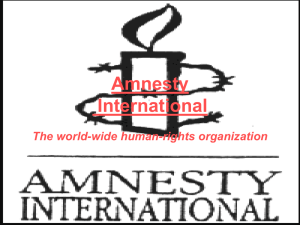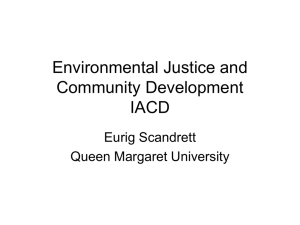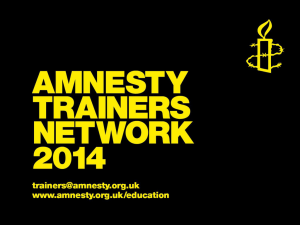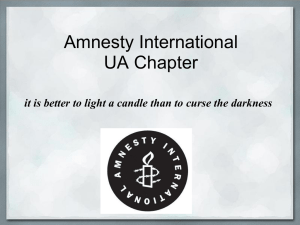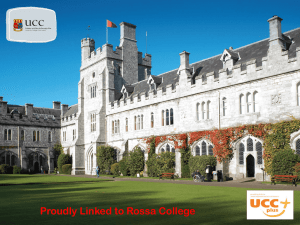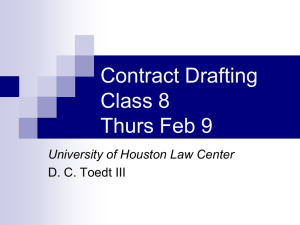30 Years is too long to get justice
advertisement
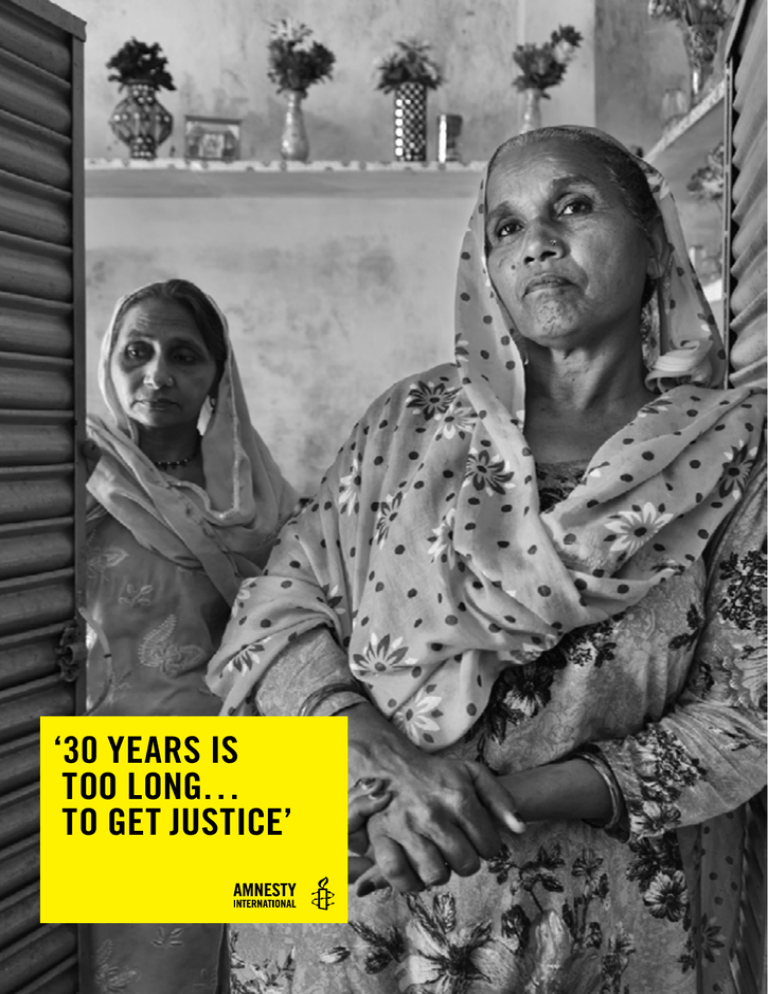
‘30 YEARS IS TOO LONG… TO GET JUSTICE’ “30 YEARS IS TOO LONG… TO GET JUSTICE” AMNESTY INTERNATIONAL DECEMBER 2014 1 “People have run out of patience. They still remember. They still cry and mourn for their family members who died that day. They feel that at least now, our government and the company must listen and take steps, because 30 years is too long… to get justice.” Safreen Khan, aged 20, whose parents survived the 1984 gas leak in Bhopal It was once known as the City of Lakes. But Bhopal has since gone down in history as the site of one of the world’s worst industrial disasters. In 1984, a toxic gas leak in the central Indian city killed and maimed tens of thousands of people. Thirty years later, that tragedy has turned into an ongoing human rights travesty. THE DISASTER From 2 to 3 December 1984, about 24 metric tonnes of methyl isocyanate (MIC), a highly volatile and deadly gas, escaped from the Union Carbide pesticide factory in Bhopal. Within three days, as many as 10,000 people lay dead. They died in agony, drowning in their own bodily fluid as their lungs collapsed. “I saw thousands of people lying there,” says pathologist Dr D.K. Satpathy, recalling the scene as he rushed to the hospital that fateful night. “Some were wailing, some were gasping, some were crying.” Yet when he and other doctors called Union Carbide, desperate for treatment information, company officials claimed 2 “30 YEARS IS TOO LONG… TO GET JUSTICE” AMNESTY INTERNATIONAL DECEMBER 2014 that the gas was no more than a mild irritant and advised medical authorities not to give a potentially life-saving drug. About half a million people were exposed to hazardous levels of toxins. Many suffered debilitating illnesses or were disabled for life. “I was vomiting, had severe chest pain and eye irritation,” says Shahzadi Bi, who still lives with her family near the factory. Her husband’s lungs were badly affected and doctors have told him that his heart has been permanently damaged. To this day, Union Carbide has refused to disclose critical details about the composition of the gas and its effect on people – information vital for providing effective medical treatment. CORPORATE CRIME Almost immediately after the leak, the Indian authorities laid criminal charges against Union Carbide India Limited (UCIL), its American parent company Union Carbide Corporation (UCC), UCC’s then Chief Executive Officer (CEO) Warren Anderson, and eight Indian UCIL employees. Later, evidence would emerge showing that UCC – the corporation at the heart of the incident – was aware of safety problems at the Bhopal plant several years before the 1984 disaster. Despite this, it kept storing huge quantities of highly toxic MIC without following proper procedures. It also failed to set up an emergency plan to warn local communities about leaks, even though it had such a plan in place at a similar plant in West Virginia, USA. When Warren Anderson came to Bhopal on 7 December 1984, he was arrested on arrival. A few hours later, he was released on condition that he return to face charges of culpable homicide (not amounting to murder) in an Indian court. He never returned, and died in September 2014, a fugitive to the end. ©Raghu Rai / Magnum Photos A few years after the disaster, UCC sold its shares in UCIL. It walked away from Bhopal, leaving behind a heavily contaminated factory site and an already battered community to cope with the pollution. In 2010 – 26 years after the disaster – seven UCIL employees, all of them Indian nationals, were convicted of causing death by criminal negligence. But UCIL’s parent company, US-based UCC, remains an absconder from justice. In 2001, UCC was bought by another US company, The Dow Chemical Company (Dow). As its 100% owner, Dow has the power to direct UCC’s conduct, yet has done nothing to ensure that its subsidiary faces the criminal charges against it. ABBREVIATIONS UCC ­­­­–­­­ Union Carbide Corporation, based in the USA UCIL – Union Carbide India Limited; UCC owned 50.9% of its shares and controlled UCIL at the time of the disaster Dow – The Dow Chemical Company. UCC has been a wholly owned subsidiary of Dow since 2001 Union Carbide – used here to refer to the Union Carbide corporate group, including UCC and UCIL To mark the 30th anniversary of the Bhopal tragedy, Amnesty International asked awardwinning photographer Raghu Rai to document the long-term effects of the gas leak on people in Bhopal. In 1984, Raghu witnessed the horrific aftermath of the leak. This digest contains a mix of archive and recent photos. Above: The abandoned Union Carbide factory casts its toxic shadow over Bhopal’s communities, December 2001. The 1984 gas leak and contamination from factory operations continue to taint the health and lives of Bhopalis. Cover: Shahzadi Bi, aged 60, Bhopal gas leak survivor, at her home in Blue Moon Colony, just a few hundred metres from the abandoned Union Carbide factory. The community is one of 22 that surround the old factory. ©Raghu Rai / Magnum Photos “30 YEARS IS TOO LONG… TO GET JUSTICE” AMNESTY INTERNATIONAL DECEMBER 2014 3 SAFREEN KHAN At 20, Safreen Khan is a new generation of activist. Too young to have experienced the disaster first hand, she has instead been defined by its aftermath. Her parents were survivors of the leak, and she continues to live in the factory’s toxic shadow. Safreen first heard about the 1984 disaster and Union Carbide, the company responsible, when she was at school. “I tried to gather more information by asking my mother. It was then that I came to understand that the problems that my family were going through started with the gas leak.” Intrigued by what she was hearing, Safreen went to more and more meetings. She watched her parents go on hunger strike with other protesters. A member of Children Against Dow-Carbide since 2008, Safreen has taken the struggle for justice for Bhopal survivors as far as the UK and the USA. 4 “30 YEARS IS TOO LONG… TO GET JUSTICE” AMNESTY INTERNATIONAL DECEMBER 2014 ©Raghu Rai / Magnum Photos “30 YEARS IS TOO LONG… TO GET JUSTICE” AMNESTY INTERNATIONAL DECEMBER 2014 5 Below: Patients at Sambhavna Clinic, which gives free treatment to survivors of the gas leak. Right: Satinath “Sathyu” Sarangi (standing, centre) and Rachna Dhingra (standing beside him) at Sambhavna Clinic. ©Raghu Rai / Magnum Photos AN ONGOING TRAVESTY In the past 30 years, more than 20,000 people have died as a result of the leak. Tens of thousands of those exposed to the gas continue to live with its effects – effects that in some cases have been passed from one generation to another. Women and girls have been particularly plagued, with frequent miscarriages, infertility and irregular periods. So widespread are these effects that medical researchers have referred to an “epidemic of “gynaecological diseases”. “And yet,” says Satinath “Sathyu” Sarangi, founder of the Bhopal Group for Information and Action, “gynaecological problems have been completely ignored.” But it’s not just survivors of the gas leak whose lives and health continue to be blighted. Bhopalis still live in the shadow of Union Carbide’s former plant. 6 “30 YEARS IS TOO LONG… TO GET JUSTICE” AMNESTY INTERNATIONAL DECEMBER 2014 Many in the local community have suffered health problems similar to those exposed to the gas, which local people attribute to ongoing environmental contamination left at the site when it was abandoned by Union Carbide. This contamination, caused by the actory before the gas leak, poisoned the water which locals were forced to drink for decades. Although campaigners recently secured clean water for some of the worst affected communities, there remains a risk that today many others still have no choice but to drink polluted water. “Today in many senses the situation of victims is worse than it was on the morning of the disaster,” says Sathyu, who is also founder of the Sambhavna Trust, which runs a free clinic for gas survivors. “There are close to 150,000 people who are battling chronic illnesses,” he notes. “Additionally we have the next generation, which we also find is marked by Union Carbide’s poisons. And on top of that we have about 40,000 people living next to the factory who have been exposed to a range of toxic chemicals and heavy metals. And there again we see a range of health problems.” The experience of Shahzadi Bi’s daughter, who was born after the disaster, is one of many such cases among the next generation cited by the community. “My daughter couldn’t conceive for four years after her marriage,” she says. “Doctors had told her clearly that ‘since you have been drinking this toxic water, you will not be able to give birth.’” ©Raghu Rai / Magnum Photos SATINATH SARANGI Satinath Sarangi (standing, centre) – or Sathyu, as he prefers to be known – was working in a small village about 100km from Bhopal when he first heard about the gas leak over the radio. At the time, it didn’t sound serious. Still, he thought he should try to help. A trained engineer, he reckoned his science background might be useful. So he went to Bhopal within a day of the leak. “I had come prepared to stay maybe a week, max,” he recalls. He came, and never left. Today, he is a founder member of the Bhopal Group for Information and Action and the Sambhavna Trust. In these 30 years, Sathyu has been a linchpin for gas survivors, their children, and those affected by water contamination caused by Union Carbide factory operations. “The disaster occurred essentially because the government prioritized foreign investment over the life and health of ordinary people,” he says. “One of the things that keeps me inspired is the spirit of the people who are among the poorest in the country. Still, they are taking on some of the mightiest of powers – the second largest chemical corporation in the world, which has the support of the US government. And [they have] not just taken them on but have actually been victorious over the years, and are passing on the spirit to the next generation.” “30 YEARS IS TOO LONG… TO GET JUSTICE” AMNESTY INTERNATIONAL DECEMBER 2014 7 2-33 De 2Dece cemb mber er 198 9844 3 Deece cemb m er mb er 198 9844 Crimin Crim inal al cha harg rges es lai aidd ag agai ains nstt UC UCIL IL, UC UCCC, War arre renn An Ande ders r on CEO, CE O and eig ight ht Ind ndia iann em empl ploy oyee eess of UCI CL 7 De Dece cemb mber er 198 9 4 Warr Wa r en And nder erso sonn arrrest sted ed;; re rele leas ased ed thr hree ee hou ours rs lat ater er 19986 Bhop Bh opal a Gro roup up for Inf nforrma mation on and Action founde dedd 1986 19 86 Indian Indi an gov over ernm nmen entt deema mand ndss Un Unioon Caarb rbid ide pa pay US US$3 $3.33 bilililonn in com o pe pens nsattio ionn 19989 8 Indian Indi a gov o er ernm nmen entt ag agre reess US$ S 47 4 0 mi milllio i n co comp mpen ensa satitonn pack pa ckag agee 19992 92 Indian Indi a cou ourtt dec ecla lare r s Warren And nder erso son and UC UCCC “a “abs bscoondder erss from fr om jus ustitice ce”” 1994 19 94 UCCC se UC sellllss UC UCIL IL sha hare ress an andd exit itss In Indi dian an mar arke kett 1996 19 96 Sambha Samb havn vnaa Tr Trus ust,t, whi hich ch run unss fr free ee clilini nicc fo forr su surv rviv ivor ors, s, foun fo unde dedd by act ctiv ivis ists ts 2001 20 01 Dow Do w ta take kess fu fullll own wner ersh ship ip of UC UCCC May 20 Ma 2004 04 Inndi dian an Sup upre reme me Cou ourtt ord rder erss cl c eann drinking ng wat ater be provid ided too com ommu muni nitities es aff ffeccte tedd by coontaamination from m UCC factor o y. Noth No thinng ha happ ppen e s. Proote test stss be begi g n. Jaanu n ar aryy 20005 0 Follow Foll owin ing caallllss by Bho hopa pall Gr Grou oupp fo forr In Info form rmattioon an andd Ac Actition on,, Inndi dian an courtt iss ssue uess summonns to Dow dem emanding it ex expl plai ainn wh whyy it has as not produ d ced UCC to face crrim i inall charrgess. Su Summ mon ons shel sh e ve vedd for eight years by b courtt, at Dow o ’ss req equesst. 20006 20 Survivoors an Surv andd ac actitivi vist stss ma marc rchh 7000km onn foott to Delhi, demanding cl clea e n wa w te ter.r. Pri rime me Min inis iste terr ag a reees. No Noth thin ingg further happens. 2009 Clea eann drinkiing wat a er arrives for or 144 co comm mmunities. Following p oteests, exte pr tendded to ei eigh ght mo m re com ommuunities in 2013. Juune 201 0100 2010 July 2013 September 2014 [GC GCTU TU CHV HVGTETKKOK O PC P NEJCTIGUƂT ƂTUV UV ƂNGF F 7%+.CPFUGXGP Indian employe y es convicted. Seven men sentennce cedd to two years KP LCK CKNN CP CPFF ƂPPGF 75 5 7%+ %+..ƂP ƂPGF GF 75 5 )QXGTPOGPVƂNGUEWTCVKXGRGVKVKQPKP5WRTGOG%QWTVVQCNNQ N Y re-negotiation of 1989 compensation settlement, but IQXGTPOGPVƂIWTGUQPFGCVJUCPFKPLWTKGUUVKNNVQQNQY Indian court re-issues summons to Dow Warren Anderson, former CEO of UCC, dies November 2014 Nine years after original summons issued, Dow still fails to appear in Indian court November 2014 (QNNQYKPIJWPIGTUVTKMGD[ƂXGYQOGPUWTXKXQTU+PFKCP IQXGTPOGPVUC[UKVYKNNTGXKUGFGCVJCPFKPLWT[ƂIWTGU for disaster in line with medical research and hospital records. Survivors declare it a major victory. 2-3 December 2014 Toxi To xicc ga gass le leak akss fr from om Uni nion on Car arbi bide de pes estitici cide de fac acto toryy, Bh Bhop opal al 30 years since the gas leak; UCC still evading criminal charges, pollution still not cleaned up, local communities continue to suffer effects of leak and contamination. Mass protests expected. “30 YEARS IS TOO LONG… TO GET JUSTICE” AMNESTY INTERNATIONAL DECEMBER 2014 A man carries the body of his dead wife past the deserted Union Carbide pesticide factory, the source of the toxic gas that killed her the night before, 5 December 1984. Between 2 and 3 December 1984, about 25 metric tonnes of methyl isocyanate (MIC), a highly volatile and deadly gas, escaped from the factory, killing up to 10,000 people within three days. ©Raghu Rai / Magnum Photos “30 YEARS IS TOO LONG… TO GET JUSTICE” AMNESTY INTERNATIONAL DECEMBER 2014 9 DR D.K. SATPATHY On the night of the gas leak, Dr D.K. Satpathy, pathologist and former head of the state MedicoLegal Institute, was dealing with the unfolding emergency at Hamidia Hospital. As patients died around him, he and his colleagues struggled to find a way to treat them. From 5 December, doctors were advised to inject patients with sodium thiosulphate, a known antidote to cyanide exposure. But this advice, which came from Union Carbide’s US headquarters, was withdrawn within days and doctors were told to stop using it. “If all the victims… would have taken this injection, the aftereffects… could have been controlled,” says Dr Satpathy. “No country must do hazardous business by compromising human health.” SHAHZADI BI Shahzadi Bi, aged 60, lives in Blue Moon Colony, one of the 22 communities that surround the old Union Carbide pesticide factory. This area is blighted by water contamination, caused by chemicals from the abandoned factory site. “I am a victim of both disasters – the toxic gas leak and toxicity in drinking water,” she explains. ©Raghu Rai / Magnum Photos The disaster overturned her and her family’s lives. “Everyone has dreams,” she says. “I too had those. My dream was not about becoming a teacher or doctor… I wished that we would provide a good education for our children… but the gas leak shattered all these dreams.” 10 “30 YEARS IS TOO LONG… TO GET JUSTICE” AMNESTY INTERNATIONAL DECEMBER 2014 ©Raghu Rai / Magnum Photos “30 YEARS IS TOO LONG… TO GET JUSTICE” AMNESTY INTERNATIONAL DECEMBER 2014 11 ©Raghu Rai / Magnum Photos UP TO WITHIN 10,000 DEAD 3 DAYS TOTAL DEATH TOLL 22,000 GOVERNMENT RESPONSE Not only has the Indian government consistently underestimated the number of people who were killed or injured in the aftermath of the leak, but it has also failed to ensure clean up of the pollution left over from Union Carbide operations. On top of this, state-provided health care is inadequate, and there has never been a proper study of the full impact of the gas leak or environmental contamination on people’s health. “Very little initiative has gone in by the government to actually document the full effects of the exposure,” says Rachna Dhingra from the Bhopal Group for Information and Action. “And that is why we are in a sad state today in terms of not having a lot of data on the chronic impacts and diseases related to the gas exposure. “But [on] the contamination issue – things are even sadder – because the government does not recognize them [people exposed to environmental contamination] as people affected by Union Carbide’s poisons. That’s why they are not even entitled to free medical treatment... So, it’s a... battle we have 12 “30 YEARS IS TOO LONG… TO GET JUSTICE” AMNESTY INTERNATIONAL DECEMBER 2014 been fighting for a very long time. And now, just recently, the Indian Council of Medical Research is going to start a project that will look into the health effects on people who have been consuming contaminated water.” The impact of the leak on women has been completely ignored, according to Rachna. “The entire gas relief structure has one hospital which functions for women and that’s just a hospital for reproduction,” she says. “The hospital facilities are so bad that if a woman needs a Pap smear she won’t be able to get it… There is absolutely nothing focused on women’s health vis-à-vis exposure-related problems.” Above: Mass cremation of victims held beside communal graves within days of the gas leak, 5 December 1984. USA – A SAFE HAVEN FOR CORPORATE CRIME? It is not only the Indian government that has failed survivors of the Bhopal tragedy. The US government is responsible for ensuring that US companies – like UCC and Dow – are held accountable for human rights abuses wherever they happen in the world. Yet it has done very little to make sure that UCC faces up to the criminal charges against it. It has, in fact, acted as a safe haven for UCC with the company effectively evading justice simply by being US-based. US courts have repeatedly rejected attempts by survivors to sue UCC for damages. This exposes serious flaws in the US legal system, which are out of step with international standards and which the government has a responsibility to address. While the USA would never stand for a foreign-owned company evading accountability after causing damage to health and livelihoods on American soil, it appears less concerned when the tables are turned. ©Raghu Rai / Magnum Photos © Amnesty International NO PROPER COMPENSATION The paltry compensation paid out to gas leak survivors is directly linked to the Indian government’s gross under estimation of the number of people who were injured or died as a result of the disaster. In 1986, the government filed a claim for compensation from Union Carbide of US$3.3 billion. In an out-ofcourt settlement three years later, it accepted a final sum capped at US$470 million. The government gave no explanation for the dramatic reduction, nor did it explain why it considered this amount acceptable. As the death and injury tolls have mounted in the intervening years, the inadequacy of the Union Carbide pay-out has grown ever clearer. So much so, that the Indian government has now gone to the Indian Supreme Court to seek further compensation from UCC. Dow is also named in the government’s petition. Bhopal activists have been lobbying hard to make sure that the government files the correct death and injury figures and comes up with an accurate – and fair – sum. In November 2014, survivor groups achieved a major victory when the Indian government told them it would revise the figures that it had submitted to the Supreme Court, in line with medical research and hospital records. If it honours this pledge, the government will have taken a significant step towards redressing an historic injustice. RACHNA DHINGRA Rachna Dhingra (seated, centre) left her job with a multinational management consultancy firm in the USA for Bhopal in 2003 after realizing she could do something to help the communities there. She’s remained ever since and today is a member of the Bhopal Group for Information and Action. “Corporations cannot just come, kill and pollute, and leave without any kind of responsibility,” she says. In the battle for accountability, activists need to be vigilant. “Just as corporations are so well equipped with all their lobbying and their lawyering and their spying and their snooping on activists,” she says, “we have to be better equipped in handling and exposing their lies.” “30 YEARS IS TOO LONG… TO GET JUSTICE” AMNESTY INTERNATIONAL DECEMBER 2014 13 RAMPYARI BAI Rampyari Bai is one of Bhopal’s most persistent survivors. Now aged 90, she began her struggle in the wake of the disaster. In 1984 she was living with her son and his wife near the factory. Her daughterin-law was seven months pregnant that night, and as the gas fumes filled the air, she suddenly went into labour. She and her baby died soon afterwards. Rampyari developed cancer and suffers from breathlessness, yet continues to fight for proper compensation. She says simply that protesting keeps her alive. “I will not leave this task of chasing governments,” she says. “Till my last breath, I will keep fighting.” A PEOPLE’S STRUGGLE Abandoned to poor health care and paltry pay-outs, survivors have fought for three decades for the corporations behind the disaster to be brought to justice. Their efforts have resulted in incremental wins, all of them secured through patience and determination. “One of the biggest things we were able to accomplish was clean drinking water for at least 60,000 people,” says Rachna. “It was not easy, because it’s a government that denies there is any contamination.” She also highlights the movement’s success in stopping “significant amounts of investment that Dow Chemical wanted to make” in India. But perhaps greatest among the successes has been the struggle itself. “We have been able to keep the issue alive for 30 years,” Rachna says simply. “That has happened because people have continued to fight. I think it is one of the longest people’s struggles in this country. I think that is a big victory.” The Bhopal struggle for justice has been largely led by women. Shahzadi Bi, Safreen Khan, Rachna Dhingra are just 14 “30 YEARS IS TOO LONG… TO GET JUSTICE” AMNESTY INTERNATIONAL DECEMBER 2014 three among many who are on the front-line of this decades-long battle that is crossing generations as well. Rampyari Bai, aged 90, is one of the community’s most persistent survivors. Her tenacity has made her a role model for a younger generation of activists. “We went for protests at many places and had so many rallies,” she says. “We swam across drains, had to run away when police ran behind us. I tell this to everyone – my sisters, brothers, mothers and daughters – that they must learn from our struggle. They must have courage and never step behind in the struggle.” True to her word, in 2011, Rampyari took part in a successful street action against Dow. Activists blocked trains from passing through Bhopal. “[Police] showered batons on us, but we were doing a peaceful protest, were merely shouting slogans,” she says. “They had beaten me so badly, four people lifted me and moved me from there.” Although the beating damaged her leg for good, Rampyari’s passion remains untouched. “I will not leave this task of chasing governments,” she vows. “I will fight for justice for gas victims… Till my last breath, I will keep fighting.” For Rampyari and so many of her fellow activists, the 30th anniversary may be their last chance to draw attention to the terrible injustice survivors have experienced. Will Dow finally accept its responsibility as a full owner of the company that destroyed so many lives? Will the USA finally play its part in making sure it does? Now is the time for the Indian government to break with the past, champion the rights of these poorest communities, and redress these injustices once and for all. Back page: Survivors of the 1984 Bhopal gas leak protest outside the Madhya Pradesh Chief Minister’s residence, demanding proper compensation, September 2014. Abandoned to poor health care and paltry pay-outs, survivors have fought for three decades for the corporations behind the disaster to be brought to justice in one of the longest people’s struggles in India. ©Raghu Rai / Magnum Photos ©Raghu Rai / Magnum Photos “30 YEARS IS TOO LONG… TO GET JUSTICE” AMNESTY INTERNATIONAL DECEMBER 2014 15 Amnesty International supports survivors and activists in the Bhopal campaign for justice. Together, we ask the Indian government to make sure that survivors of the gas leak get the compensation they deserve and the medical treatment they need. We also ask it to urgently clean up the Bhopal site, ultimately making the companies responsible for the pollution foot the bill. JOIN THEM We ask the US government to help address all outstanding issues, including by applying political pressure to ensure that the companies involved pay adequate compensation to the survivors and cover the costs of the clean-up. Their campaign has been resilient and powerful, but Bhopal’s survivors and activists can’t do it all alone. Join in, on this 30th anniversary, and help them achieve their decades-long struggle for justice. Write a letter, change their lives at http://bit.ly/writebhopal We also ask the governments of India and the USA to make sure that UCC and Dow comply with Indian court orders and face their day in court. Amnesty International is a global movement of more than 7 million people who campaign for a world where human rights are enjoyed by all. Amnesty International, International Secretariat, Peter Benenson House, 1 Easton Street, London WC1X 0DW, United Kingdom Our vision is for every person to enjoy all the rights enshrined in the Universal Declaration of Human Rights and other international human rights standards. Index: ASA 20/035/2014, English, December 2014 We are independent of any government, political ideology, economic interest or religion and are funded mainly by our membership and public donations. AMNESTY.ORG ©Raghu Rai / Magnum Photos JUSTICE NOW
